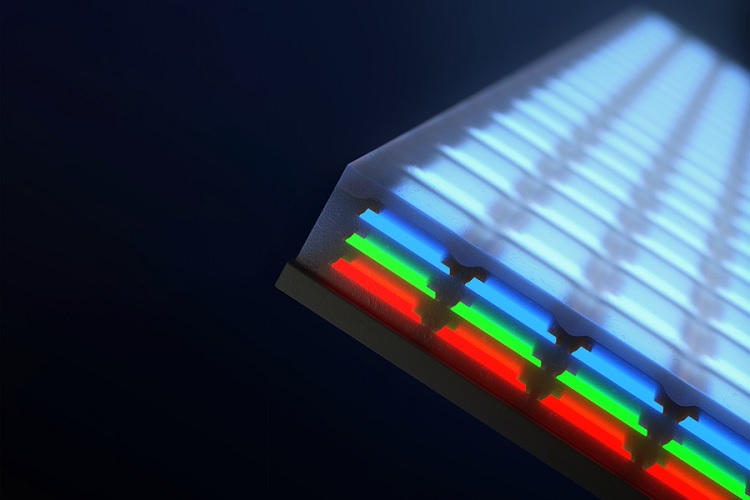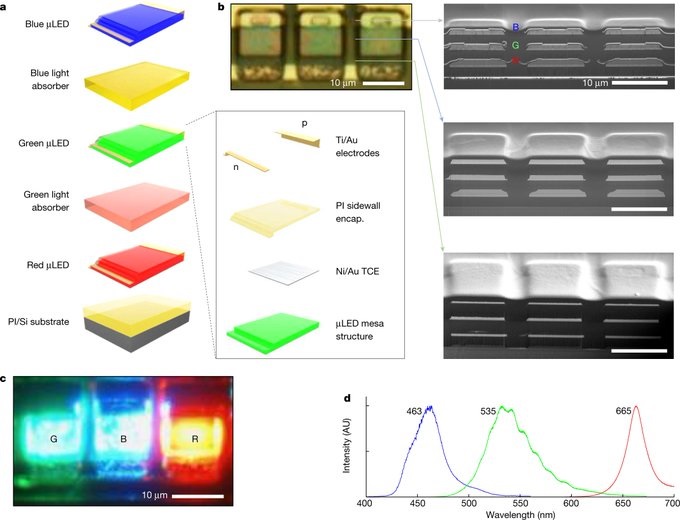
In Augmented Reality and Virtual Reality News
February 6, 2023 – MIT has recently announced that its engineers have developed a new way to make sharper, defect-free displays, with the invention of vertical, full-color microscopic LEDs.
LEDs are reaching a limit as to how small they can be while still performing effectively. This limit is especially noticeable in close-range displays such as augmented and virtual reality (AR/VR) devices, where limited pixel density results in a “screen door effect” such that users perceive stripes in the space between pixels.
To solve this issue of size, instead of placing red, green, and blue LEDs (light-emitting diodes) side by side in a horizontal patchwork, a team at MIT has invented a way to stack the diodes to create vertical, multicolored pixels.
According to MIT, each stacked pixel can generate the full commercial range of colors and measures about 4 microns wide (for context, a human hair ranges anywhere from 17-181 microns). The microscopic pixels, or “micro-LEDs,” can be packed to a density of 5,000 pixels per inch.
“This is the smallest micro-LED pixel, and the highest pixel density reported in the journals,” said Jeehwan Kim, Associate Professor of Mechanical Engineering at MIT. “We show that vertical pixelation is the way to go for higher-resolution displays in a smaller footprint.”
“For virtual reality, right now there is a limit to how real they can look,” said Jiho Shin, a postdoc in Kim’s research group. “With our vertical micro-LEDs, you could have a completely immersive experience and wouldn’t be able to distinguish virtual from reality.”
The team’s results have been published in the journal Nature. Kim and Shin’s co-authors include members of Kim’s lab, researchers around MIT, and collaborators from Georgia Tech Europe, Sejong University, and multiple universities in the US, France, and Korea.

In a blog post covering the announcement, MIT noted that today’s digital displays are lit through organic light-emitting diodes (OLEDs), which are the leading digital display technology. However, the diodes can degrade over time, resulting in permanent burn-in effects on screens. The technology is also reaching a limit to the size the diodes can be shrunk, limiting their sharpness and resolution.
For next-generation display technology, researchers at MIT are exploring inorganic micro-LEDs — diodes that are one-hundredth the size of conventional LEDs and are made from inorganic, single-crystalline semiconducting materials. Micro-LEDs could perform better, require less energy, and last longer than OLEDs, according to MIT.
However, one issue with micro-LEDs is that their fabrication requires extreme accuracy, with microscopic pixels requiring an extremely high level of microscopic precision to ensure exact alignment. Entire devices need to be scrapped if pixels are found to be out of place.
To address this issue, the MIT team has come up with a potentially less wasteful way to fabricate micro-LEDs that doesn’t require precise, pixel-by-pixel alignment. The technique is an entirely different, vertical LED approach, in contrast to the conventional, horizontal pixel arrangement.
“In conventional displays, each R, G, and B pixel is arranged laterally, which limits how small you can create each pixel,” Shin added. “Because we are stacking all three pixels vertically, in theory we could reduce the pixel area by a third.”
As a demonstration, the team fabricated a vertical LED pixel, and showed that by altering the voltage applied to each of the pixel’s red, green, and blue membranes, they could produce various colors in a single pixel.
“If you have a higher current to red, and weaker to blue, the pixel would appear pink, and so on,” Shin explained. “We’re able to create all the mixed colors, and our display can cover close to the commercial color space that’s available.”
The team at MIT stated that it plans to improve the operation of the vertical pixels. So far, they have shown they can stimulate an individual structure to produce the full spectrum of colors. Work will continue toward making an array of many vertical micro-LED pixels.
“For now, we have shown to the community that we can grow, peel, and stack ultrathin LEDs,” noted Kim. “This is the ultimate solution for small displays like smart watches and virtual reality devices, where you would want highly densified pixels to make lively, vivid images.”
This research was supported, in part, by the US National Science Foundation, the US Defense Advanced Research Projects Agency (DARPA), the US Air Force Research Laboratory, the US Department of Energy, LG Electronics, Rohm Semiconductor, the French National Research Agency, and the National Research Foundation in Korea.
Image credit: MIT / Nature (Twitter)
About the author
Sam is the Founder and Managing Editor of Auganix, where he has spent years immersed in the XR ecosystem, tracking its evolution from early prototypes to the technologies shaping the future of human experience. While primarily covering the latest AR and VR news, his interests extend to the wider world of human augmentation, from AI and robotics to haptics, wearables, and brain–computer interfaces.
